This story was created by Steve Englehart, Neal Adams, and Frank Brunner. They are three of the greatest names in comic-book history and we may have underestimated them. The story itself is seriously overlooked. Suspiciously so.
By that I mean the story has not been reprinted as a trade, which is kind of odd. Makes me suspicious. Oh, yes, it is in the full reprint of Dr Strange titles, but they do that for everyone and every thing.
But with the movie coming, a lot of Dr Strange material is available. But not this one which is about time travel (like the movie), recursion in time travel (like the movie), and other common themes and areas of interest. Is this the inspiration for the third solo Dr Strange movie?
The prestory came out in November 1973, and the first issue of the story came out in December 1973 in Marvel Premiere Featuring Dr Strange Master of the Mystic Arts #13 (dated January 1974). That will be important. And before this story there is a leadup which I will cover, because it becomes important.
The story is Sise-Neg Genesis, which tells you the whole plot and we’ll get back to that, too. This whole story is intertwined in plot, theme, and image.
Before it begins, Baron Mordo finds a book written by Count Cagliostro, guarded by his own niece. It details how to change the past without endangering your position in the present. Go back, kill your grandparents before your parents are born, but somehow you still exist.
Mordo steals the book from Lilia the Gypsy Queen, his own niece. He sets a gargoyle to guard it. Lilia and Dr Strange show up to get back. Lilia dies. Mordo cares more for power than his niece.
Dr Strange looks at the book and it’s open on the very page he needs. Mordo cast a failsafe spell to put the book into the past. But as it was open to that page in the past, it opens to the same page now. It tells him how to follow Mordo. Mordo wants to change the past so he will be the Sorcerer Supreme, not Strange.
The thing that doesn’t strike you before the second reading is Mordo is seeking power through changing the time stream. That is half the theme of the whole story.
Note that in this story, Strange and Mordo each has a cloak of levitation. Strange’s cloak has a spike on either side of the collar and they are normally drawn hooked and short. In this case they are tall spikes, similar to the spikes of Mordo’s costume. Mordo has a chest symbol instead of Strange’s amulet. Strange has a skirt and Mordo has a breach clout. Both men have gray at the temples. They look remarkably similar, even for them.
As they battle, they find their powers reduced. In the battle, Mordo declares he will destroy Strange if he can. Strange immediately asks, “does life mean so little to you, and power so much?” This encompasses the whole struggle between them. This is a major theme of the story.
Basically, Mordo is Lucifer. He wants power above all else. He will rebel against the good if it gives him more power. He will deny love. This is the plot of Paradise Lost and this story.
A waveof weakness tells Mordo he’s reached his destination. He returns to our reality. Strange follows and comes out in eighteenth century Paris. The time of Cagliostro, who wrote that book.
Strange approaches him in his own home. He tells Cagliostro of Baron Mordo’s plan. Cagliostro is taken aback, but is unimpressed. He refuses to get involved in the struggle between Strange and Mordo and leaves reality.
Strange disguises himself as Cogliostro and waits for Mordo. Mordo shows up but sees through the disguise. They fight and, again, their spells are less than usual. Strange catches Mordo in the light of the Eye of Agamotto. Mordo breaks free, which he should not be able to.
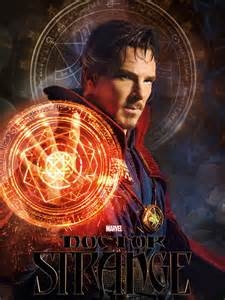
That sigil which sometimes looks like a giant watch seems to have been influenced by Enochian Magic.
Someone comes to the door and Strange again disguises himself as Cagliostro. The new visitor is Dr Strange, who says exactly what Dr Strange said when showed up in the first place.
Strange reverts to his real form, the doppleganger disappears, and Dr Strange contemplates this odd turn of events watched by a small wingless gargoyle which is on a ledge of an incomplete stone arch.
Cagliostro returns and takes form on the same arch, the gargoyle nowhere to be seen. Cagliostro, symbolically, is in the same position as the gargoyle. He attacks Strange. Mordo returns and joins the attack and they succeed. Mordo shouts his triumph, that finally, he wins, and declares he will be the ruler of the world. Again, this is his focus on power.
Mordo declares Cagliostro a competent ally (ego, much). Cagliostro instantly flattens Baron Mordo. “I don’t take allies.” He then does a villain monologue.
He is not Cagliostro, who is in Transylvania (where Lilia will live) fighting Dracula. He is a thirty first century magician named Sise-Neg. In his time, it’s a known fact that the amount of magical energy is limited and with three quarters of the population using magic for everyday purposes, there isn’t much to go around.
So Sise-Neg goes back in time. With fewer magicians he gets a larger share of magical energy. He already has so much that neither Dr Strange nor Baron Mordo can operate at their usual levels.
His travels creates whirlpools in time. That’s why the odd events like time repeating itself happened. Throughout the story similar parallels appear usually in the background of the story.
Sise-Neg stopped to write a book giving an outline of his methods, so people can admire him. He wrote the book of Cagliostro. But anyone who admires the skill of this genius in time travel will admire Cagliostro, not Sise-Neg.
So Sise-Neg has a pathological ego. He wants approval and admiration and then turns that approval to another man. Sabotage yourself much? Want power much? Are you like Mordo, much?
Having done that, he will go to the dawn of time, gathering up all magical energy as he goes. What do you call an all-powerful being at the dawn of time? “God,” he says, and then he leaves.
Basically, Sise-Neg is following the same plan as Mordo, who wants to be Sorcerer Supreme, but Sise-Neg has real ambition about it and isn’t a piker.
Mordo decides to still be an ally of Sise-Neg, grovelling as much as he needs to so he can get a boon. In other words, he is still devoting himself to power and will abase himself as much as anyone else to get it. Just think election year and Mordo enters the time stream.
Dr Strange rises and follows, because Sise-Neg is the greatest threat the universe has ever faced. It is a noble act, and this is what Dr Strange does. Basically,, he operates from love – what, that old thing?
And all that is just the set up of the story. But the themes are almost set. As Sise-Neg travels Mordo and Strange become his bad and his good angels, which is something that has long been noted by critics. What I haven’t seen is mention that Mordo is for power, Strange for love. There are four stops on the way, let’s look at the first.
Sise-Neg stops his travels because he’s curious to discover the source of the magic he detects. Note the tree on the right hand side of the panel. It will be important. Also, Sise-Neg himself now glows from all the energy he’s absorbed. As you do.
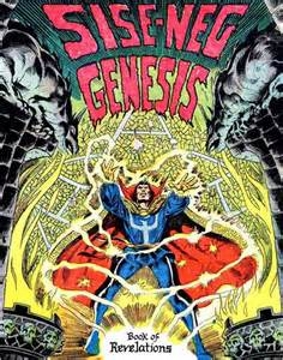
The gargoyles we see in Cagliostro’s house (and other places) but no reference to the Book of Revelations in the story – sorry Midwest.
He sees a knight and to amuse himself he creates a dragon. He’s heard of such fights and wants to watch one. The dragon is wingless, like the gargoyle Mordo left to protect the Book of Cagliostro and the gargoyle in Cagliostro’s house.
These creatures signal choices of action which come out badly. Lilia dies, Sise-Neg turns against Dr Strange, and now. Sise-Neg lets Dr Strange help the knight. Having far less strength that usual, Dr Strange has to find another way. He notes that the dragon has no eyelids. He uses the light of the Eye of Agamotto to blind the creature which then crashes into a mountain side, causing an avalanche which kills it.
The knight thanks Strange, thinking he is Merlin. The knight is Lancelot and, as Mordo says, his “oh-so human” love for Queen Guinevere will destroy Camelot. Why he says oh-so human (hyphen in the original) is a mystery, since prior to this love is not an issue in the story and Sise-Neg has never said a word against it. But from now on Mordo will champion power to Sise-Neg, and Strange will champion love in various forms.
He begins by defending human love even if he’s not aware of it at first. And, as in all cases, Strange deals with a lack of power. After all, if you have power over love, it is not love.
Mordo says people cannot control themselves and they need a strong leader, in this case Sise-Neg.
Sise-Neg says he will ponder this, and the time travel resumes with Dr Strange following last and knowing that did not go well.
They stop again, at a city. Sise-Neg is now just a giant floating head, still glowing. The power he absorbs keeps changing him. The city has giant idols, scantily clad (for back then) women, and according to the magical perceptions the people are lost in sin and degradation and so dissipate their own magical energies.
This is the first time ideas like sin and proper behavior has entered the vocabulary, and it is closer to Strange’s view than Mordo’s. But Mordo suggests destroying them to seize their power right away. No one seems to notice this is a form of human sacrifice. Dr Strange opposes the plan. He says you can’t just murder people and Sise-Neg doesn’t know what they’re really like.
Note that it was a personal love first time round, this is social interaction, taking a place in society, becoming an adult.
Sise-Neg takes human form and brings Mordo and Strange with him as he appears in the city. This is a shift, because he is bringing both with him.
He demands to be brought to the city’s leaders or he will kill everyone. How could any non-psychotic whose job isn’t professional wrestling think this is an OK way to introduce yourself? It’s all power and no love, like that Malfoy kid.
The populace call the priests of death who, without a single question, decide to kill the trio. Strange throws up a shield but Mordo is a coward and doesn’t help. Again, love tries when power wants a guarantee.
Sise-Neg loses his temper, and the city is destroyed. There are only a few survivors, one of whom tells his wife they must forget there were ever such cities as Sodom and Gomorrah. It didn’t go well for Strange. He supported the love that lets one fit into society, the love between Lot and his wife and it failed.
They go back into the time stream only to stop a third time. This time they stop in a time of volcanoes and dinosaurs and primates who are almost human but not there, yet. The landscape is utterly void of plant life.
Mordo says Sise-Neg favors him, now. Strange says Strange’s love of humanity is a path to disaster.
What they see is dinosaurs fight like wingless gargoyles or dragons. And the half-ape half-men they see are running in fear from something. Strange mentions this to Sise-Neg who tells him to shut up.
Then come the tentacles seeking the half-men half-apes. And after them, the head. Dr Strange recognizes Shuma-Gorath. Because of it, the Ancient One had to die. Strange realizes that Sise-Neg first had to stop for Merlin, the magic of one man, then he stopped for a whole cult, and now he has to stop for a cosmic menace. This reinforces that there has been a raising of stakes.
Dr Strange goes so the creature will not kill again. But the death of the Ancient One occurs in the future. Again, it is significant. The whirlpools and eddies are getting bigger.
Dr Strange attacks but he has so little energy that his spells make him invisible. He does the only thing he can, he asks Sise-Neg for a boon just as Mordo planned to do. Sise-Neg reminds Strange that with the merest thought…
But Strange interrupts him, says he accepts the danger of death to make Sise-Neg see those people. He may transcend them but they are his ancestors and he and they are one. Can he really leave them to an inhuman cosmic entity? He won’t get anything out of it, but he can show love.
Sise-Neg puts Shuma-Gorath to sleep, taking as much energy as he can. He puts the it into another dimension, from which it won’t return for millenia – just in time for the battle which will kill the Ancient One.
Then he creates a garden for the remaining two hominids. This is done in two panels and in the first is a small dimetrodon, with the fin on its back, on the right. It is effectively another gargoyle. In the upper left of the second panel is an apple. On the right is a tree of the sort shown on the right of the panel when they appear in Arthur’s time.
Sise-Neg, a floating head with an expanded cranium that glows, goes back to the time stream. They stop near the beginning of the universe. Mordo tries to get a favor but Sise-Neg doesn’t listen. The universe goes back to its origin and Sise-Neg realizes he had been wrong.
The universe is always in harmony, if one can but see it. Since power is there for a lack of harmony, it implies Strange’s view of love is the was right despite its failings.
Sesi-Neg recreates the universe exactly as it was. Sise-Neg says he wants to be known as the God, Genesis. Time starts again and Mordo and Strange are out in their own time. It turns out to be New Years 1974, which is when the first comic in the series was dated, January 1974.
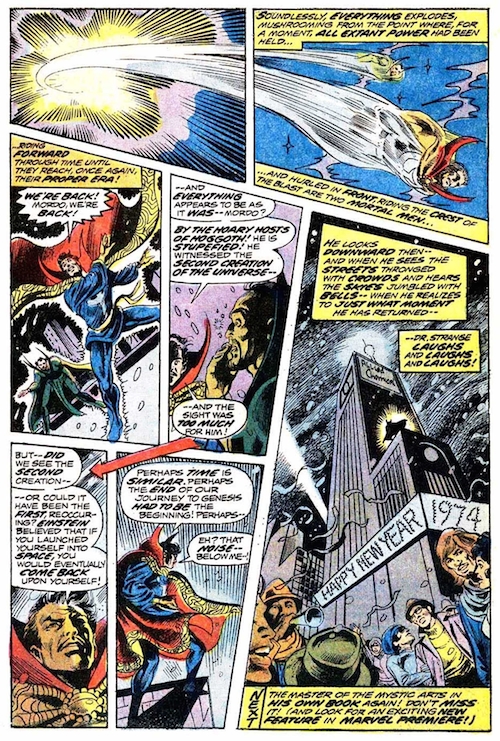
Happy New Year: with time travel this greeting is always current. Where’s my birthday presents? And Christmas. Every day is Christmas.
Sise-Neg is Genesis backwards. So the title of the story, Sise-Neg Genesis is a palindrome which tells the whole plot. The man goes back in time that creates the universe again. In doing so, he learns of love in its various forms, while power is a one note song. I still think Sise-Neg Genesis will be the movie.

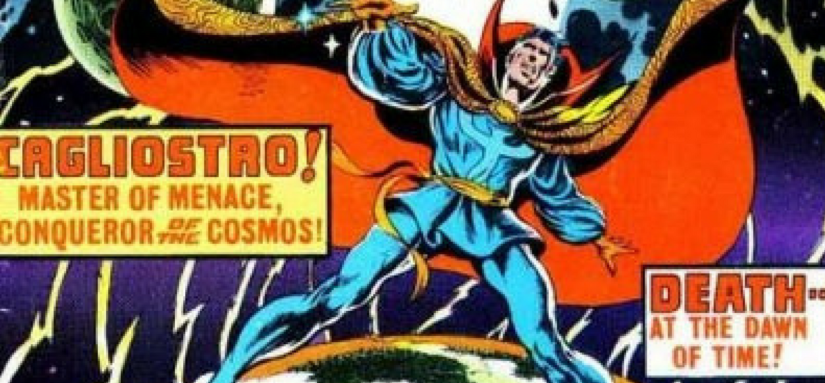
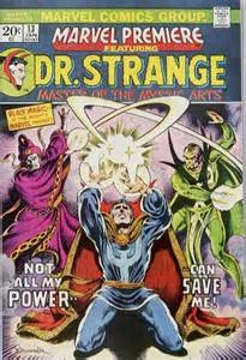
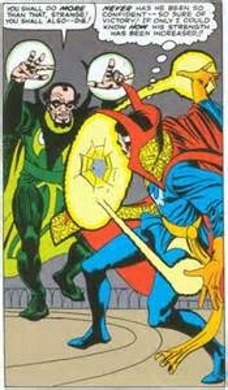
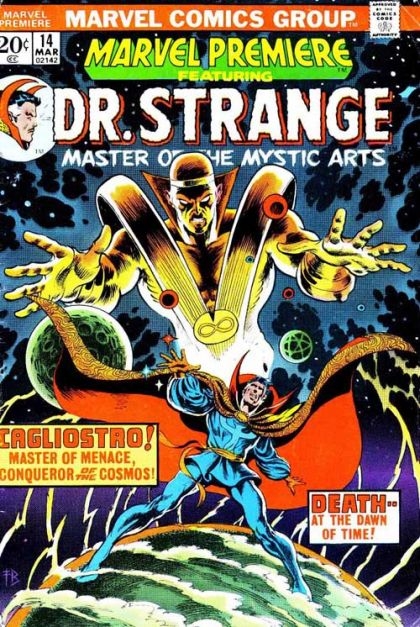
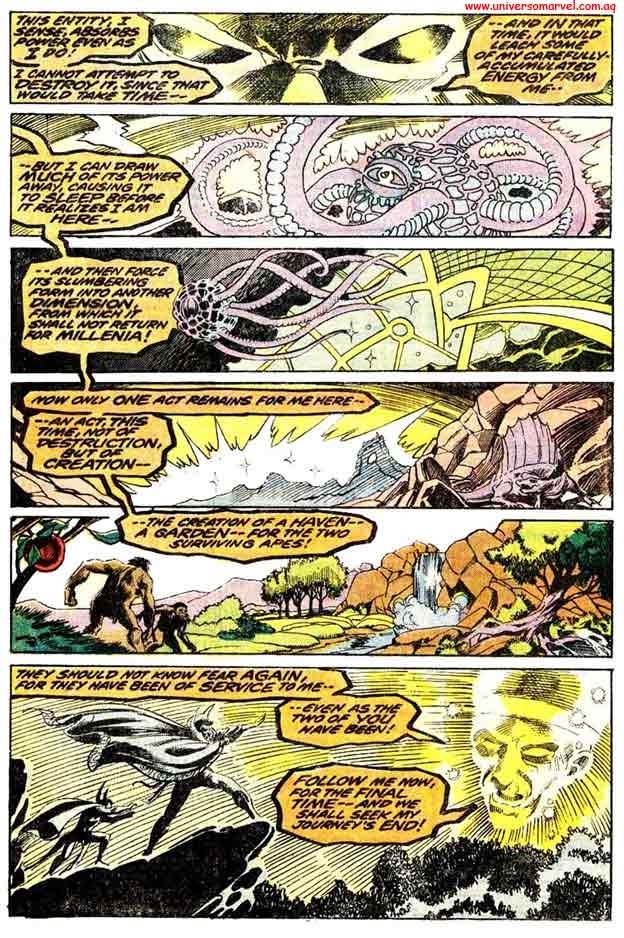
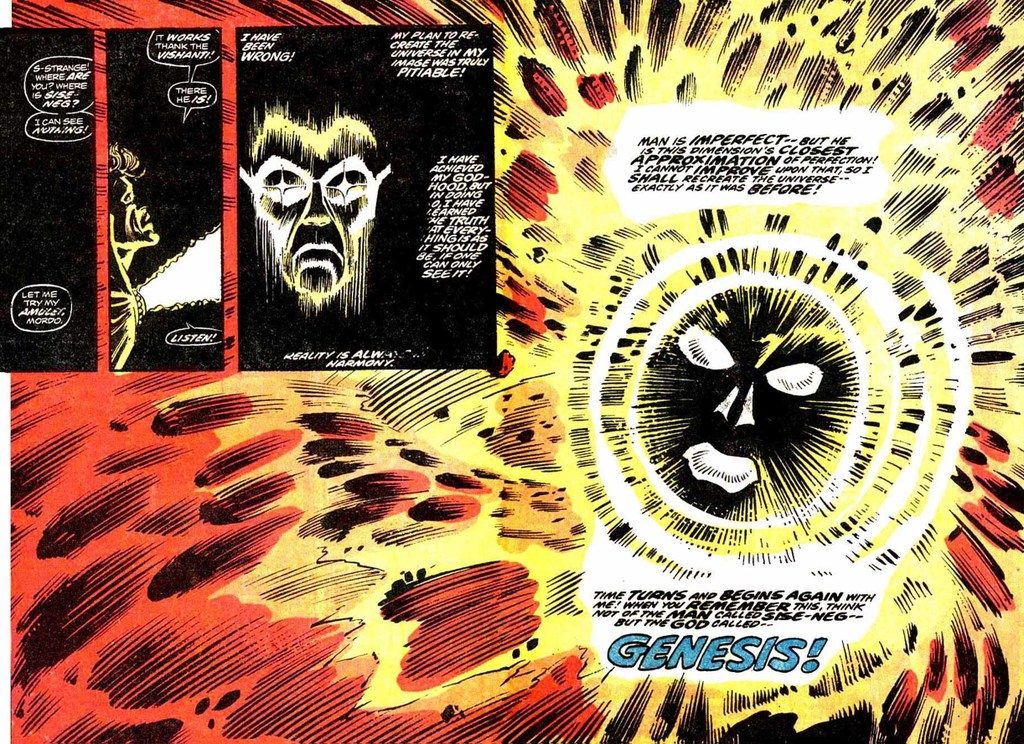
Comments are closed.